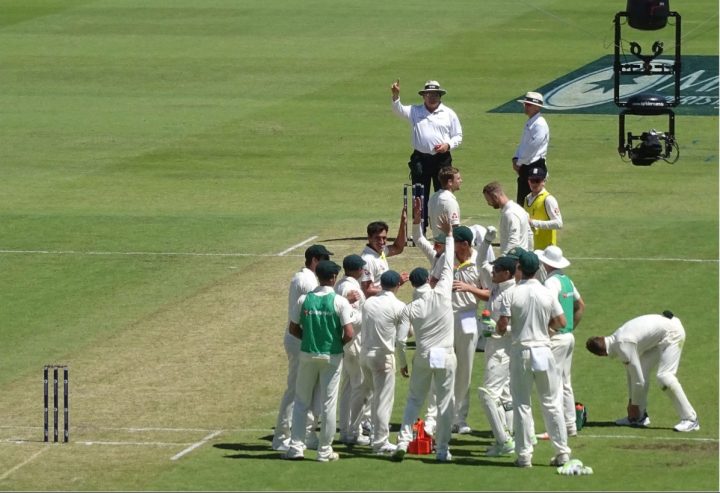This has turned into the battle of the last-wicket partnerships. And while England’s disastrous middle-order collapse is likely to dominate the headlines, the counter-attack begun by Broad, and then continued by Root and Anderson, have repaired a substantial amount of the damage.
England can still win this match. If the deficit can be reduced to around seventy, it will be India who’ll feel under pressure in the third innings. Were England to bowl them out for 250 – not impossible if the visitors lose their nerve – it’s game on.
England can take some solace in a commendable fightback from 202-7 to 352-9 which turned certain defeat into a half-chance of something better. MS Dhoni must have been tearing his hair out, much as Alastair Cook did while Kumar and Shami compiled 11 on Thursday.
Another way of looking at it, though, is to regard the flurry of wickets in each innings as the aberrations, the pitch as unresponsive as it is, and the reciprocal rallies by the tail as an exaggerated restoration of the status quo.
It’s hard to put one’s finger on why England are still collapsing. Yesterday it was 6 for 68; at Lord’s against Sri Lanka 6-75; and at Headingley 5-18.
This follows the horrorshow in Australia, in which England collapsed in nine out of the ten innings. The roll call of dishonour reads:
– Brisbane: 8-54 and 7-49
– Adelaide: 6-24
– Perth: 6-61 and 4-17
– Melbourne: 6-53 and 5-6
– Sydney: 5-17 and 4-8.
But those implosions were at the hands of Mitchell Johnson and Ryan Harris (and admittedly, Nathan Lyon) on pace-friendly wickets.
This summer, the bowlers have been slower and the pitches even more so. What’s more, three of the batsmen are different. The puzzling thing about the continuation of the trend is that the new bats have all done well. The only man in genuine poor form is Cook, who hasn’t been involved in the collapses.
Is it down to the general level of inexperience? To Bell’s renewed air of flakiness? Or to something less tangible – a general lack of fortitude and confidence, a hangover from the traumas of the winter?
The fact that India’s bowlers have as a unit outperformed England’s is not quite explanation enough.
The England dressing room’s view is probably that two of the wickets – Robson’s and Prior’s were invalid.
There will be a lot of talk over the next few weeks about the absence of DRS in this series. My view is that India are perfectly within their rights to refuse its use. DRS is not part of the laws of the game; rather it is a playing condition, and as such must be mututally agreed.
India’s core objection – that ball-tracking is an inexact science – is hard to completely refute. From a spectator perspective, test cricket without DRS feels purer, more fluent, and more organic. Human error – which in cricket includes the umpires’ – is an indispensable layer of sport’s appeal.
But those are only my thoughts. We welcome all your views and thoughts on day three’s talking points, in the comments below.










England do need to look long and hard at the collapses. It makes them very vulnerable, especially as it isn’t always great bowling that causes it.
As for DRS, I disagree. Cricket doesn’t feel better because games are affect by umpires make mistakes. A game is about the contest between 22 players and not the quality or otherwise of the Umpires. It’s like claiming that life was better when you had to go and fetch water from the well. This dangled pumping system and increase in water hygiene is terrible, we are missing out on waterborne illnesses.
The technology has improved the quality of decision making of umpires and ensured that the art I finger spinning is still alive. Club cricketers, those who play the game for pleasure not pay, are hardly ever seen to smile and say ‘that’s the beauty of the game’ when given out to a howler like Prior. Indeed, as spectators, we were denied watching Vijay, perhaps, scoring a double hundred.
It is a fallacy to say technology is a bad thing. It is how it is used which matters. Yet the BCCI seem reluctant to even engage in a discussion about it because it isn’t 100% accurate. Neither is Dar and his colleagues… Yet that is a good thing. The logic doesn’t added up.
Broad and Anderson to open the batting and England may have a chance but, honestly, when did England last chase a score in a test match and win????
Not so crazy. Last 7 knocks:
Cook 7, 7, 17, 28, 17, 16, 5
Broad 30, 42, 47, 24, 4, 0, 47
“England can still win this match. If the deficit can be reduced to around seventy, it will be India who’ll feel under pressure in the third innings. Were England to bowl them out for 250 – not impossible if the visitors lose their nerve – it’s game on.”
So India lead by 70 and get bowled out for 250? That means that England would be unlikely to be batting until the start of play tomorrow and would have to score 320 runs in the day to win the match. I can’t see that happening on this pitch.
What frustrates me about Bell is that the great players really cash in when they get a start and rarely give their wicket away. He does it time and again after appearing a class apart for his first 30-40 runs, it’s the no.4 & no.5 who should really build on a good start rather than giving it away and triggering panic. If he was out of nick it would be easier to take somehow.
Rant over. Come on Jimmy!
Great fightback by Root and the tail, but the middle order collapse on such a flat pitch is far greater concern than against Super Mitch and his pals. Still think talk of an England win is a bit fanciful.
On DRS, we couldn’t have had two better examples yesterday of why it should be used in all international cricket, whether India like it or not. It may not be perfect but it’s still much more reliable than the naked eye.
I Can’t understand why people are still so sniffy about technology. In the mid 19th century there was no video or film. High tech was putting 2 blokes in white coats as close as possible to the action. But as always what starts has cutting edge quickly becomes “tradition” that must be preserved.
As to why India won’t use it ,the reason is they obviously feel they get a better advantage without it. Perhaps the power India exerts on the game as a whole can be transferred onto the umpires. Do you as an umpire want to keep giving decisions against India when your career may depend on it?
What is really inexcusable is the jelly like spines of the other test playing nations who allow India to dictate these matters. But as Giles Clarke seems to spend his whole time on his knees regards any negotiations with the Indian playground bully don’t expect any change.
“Test cricket without DRS feels purer, more fluent and more organic”.
How pure would the Lord’s test against the Lankans have felt if the Pradeep LBW had stood?
“Ball tracking is an inexact science”.
Possibly but this is built in to DRS with ‘umpire’s call’. Also, if this is the only problem, why not use the rest of DRS in this series?
“Human error – which includes in cricket the umpires – is an indispensible layer of sport’s appeal”.
Human error by the players is – the umpires are there as the neutral arbiters of the rules. By your logic, let’s have more umpiring mistakes and make the game more appealing!
More generally:
Most sports use TV replays in some form now e.g. rugby, tennis, horse racing. The main exception is football and I’d regard it as clinching argument that anything Sepp Blatter is against must be a good thing!
Thanks for all your comments. I’m not denying there’s a strong case for DRS. Personally, my diffidence towards it is more emotional than rational, perhaps. But what would sport be without emotion?
I take the point that India expect special treatment. What would happen if it were Bangladesh, or even England, who alone refused to use DRS?